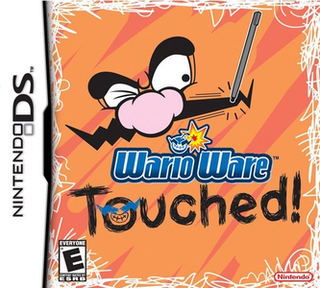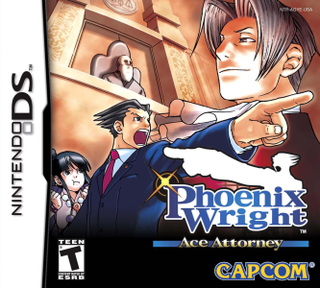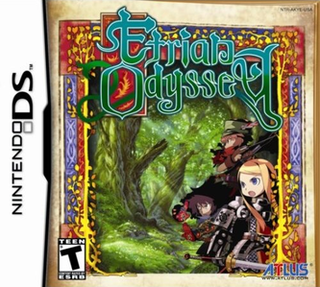Metroid is an action-adventure game franchise created by Nintendo. The player controls the bounty hunter Samus Aran, who protects the galaxy from Space Pirates and other malevolent forces and their attempts to harness the power of the parasitic Metroid creatures.
Megami Tensei, marketed internationally as Shin Megami Tensei, is a Japanese media franchise created by Aya Nishitani, Kouji "Cozy" Okada, Ginichiro Suzuki, and Kazunari Suzuki. Primarily developed and published by Atlus, and currently owned by Atlus, the franchise consists of multiple subseries and covers multiple role-playing genres including tactical role-playing, action role-playing, and massively multiplayer online role-playing. The first two titles in the series were published by Namco, but have been almost always published by Atlus in Japan and North America since the release of Shin Megami Tensei. For Europe, Atlus publishes the games through third-party companies.

WarioWare: Touched! is a minigame compilation party video game released by Nintendo for the Nintendo DS. The fourth installment of the WarioWare series, and the first of three on the Nintendo DS, the game involves rapidly completing "microgames" — simple minigames lasting extremely short periods of time — as quickly as possible. The microgames are exclusively controlled with the Nintendo DS's touchscreen and microphone.

Urban Champion (アーバンチャンピオン) is a fighting video game developed and published by Nintendo in 1984. It was first released for the Famicom and Nintendo VS. System for arcades in 1984, and later released for the Nintendo Entertainment System in North America and Europe in 1986. It was inspired by the 1984 Game & Watch game Boxing. It is Nintendo's first 2D fighting game, eventually followed in 1993 by Joy Mech Fight, released exclusively in Japan for the Famicom.

Phoenix Wright: Ace Attorney is a visual novel adventure game developed and published by Capcom. It was released in 2001 for the Game Boy Advance in Japan and has been ported to multiple platforms. The 2005 Nintendo DS version, titled Gyakuten Saiban Yomigaeru Gyakuten in Japan, introduced an English language option, and was the first time the game was released in North America and Europe. It is the first entry in the Ace Attorney series; several sequels and spin-offs were produced, while this game has seen further ports and remasters for computers, game consoles, and mobile devices.

Trauma Center: Under the Knife is a simulation video game developed by Atlus for the Nintendo DS. The debut entry in the Trauma Center series, it was published in Japan and North America by Atlus in 2005, and by Nintendo in Europe in 2006. Set in a near future where medical science can cure previously incurable diseases, the world's population panics when a new manmade disease called GUILT begins to spread. Doctor Derek Stiles, a surgeon possessing a mystical "Healing Touch", works with the medical group Caduceus to find a cure to GUILT. The gameplay combines surgery-based simulation relying on the DS's touchscreen controls with a story told as a visual novel.

Trauma Center: Second Opinion is a simulation video game developed by Atlus for the Wii. The second entry in the Trauma Center series, Second Opinion is a remake of the Nintendo DS title Trauma Center: Under the Knife (2005). The game was released in North America and Japan in 2006 by Atlus as a console launch title, and in other regions in 2007 by Nintendo.

Etrian Odyssey is a 2007 3D dungeon crawler role-playing video game by Atlus for the Nintendo DS. It centers around first-person exploration of a mysterious dungeon known as the Yggdrasil Labyrinth using a player-created party of characters. The game received mixed to positive reviews from critics, who criticized its punishing difficulty as limiting its appeal, but also making its gameplay more rewarding.
Puzzle Series is a series of puzzle video games by Hudson Soft.

Final Fantasy Fables: Chocobo's Dungeon is a 2007 role-playing video game published by Square Enix for the Wii. It is an installment in the Chocobo series that focuses on Chocobo and his quest to free a town lost in time from eternal forgetfulness. It is a loose sequel to Chocobo's Dungeon 2 on the PlayStation.

Pokémon Mystery Dungeon is a video game series spin-off from the main Pokémon series developed by Spike Chunsoft. The games feature the fictional creatures called Pokémon who have the ability to speak human language navigating through a randomly generated dungeon using turn-based moves, common to Mystery Dungeon games. As of March 2020, there have been eleven games across five platforms, as well as several manga adaptations and animated specials.

Trauma Center: New Blood is a simulation video game developed by Atlus for the Wii. The third entry in the Trauma Center series, the game was published in North America in 2007 by Atlus, and in other regions in 2008 by Atlus (Japan) and Nintendo. The story follows doctors Markus Vaughn and Valerie Blaylock, each holding a supernatural ability called the Healing Touch, as they face a man-made parasitic virus called Stigma. Gameplay combines surgical simulation with a story told as a visual novel, with operations controlled exclusively using the Wii Remote and Nunchuk.

Trauma Center: Under the Knife 2 is a 2008 simulation video game developed by Vanguard for the Nintendo DS (DS), and published by Atlus. It is the fourth game in the Trauma Center series and a direct sequel to Trauma Center: Under the Knife (2005). Set three years after the events of Under the Knife, the plot follows protagonist Derek Stiles as he confronts not only the revival of terrorist organisation Delphi and its GUILT disease, but personal insecurities and corporate manipulation. The gameplay combines surgical simulation relying on the DS's touchscreen controls with a story told as a visual novel.

Trauma Team is a 2010 simulation video game developed and published by Atlus for the Wii. It is the fifth and current final entry in the Trauma Center series. The narrative of Trauma Team follows six protagonists who operate in different sectors of the medical profession, and their united conflict with a virulent infection dubbed "Rosalia". The gameplay combines medical simulation with visual novel-style storytelling through motion comic cutscenes. The different storylines focus on simplified versions of surgery, emergency medicine, endoscopy, diagnosis, orthopedics and forensic medicine.

Radiant Historia is a role-playing video game co-developed by Atlus and Headlock for the Nintendo DS. It was released in Japan in 2010 by Atlus, and in North America in 2011 by their subsidiary Atlus USA. An expanded remake for the Nintendo 3DS, titled Radiant Historia: Perfect Chronology, was released in 2017 in Japan and released in North America and Europe the following year, with the European version being published by Deep Silver.
Art Academy is a series of edutainment video games beginning in 2009 with Art Academy. Its most recent release was Disney Art Academy. One of Nintendo's franchises, the series has been released on Nintendo DS, Nintendo 3DS and Wii U.

Persona Q2: New Cinema Labyrinth is a 2018 dungeon crawler role-playing video game by Atlus for the Nintendo 3DS. It is a spin-off of the Persona series, itself part of the larger Megami Tensei franchise, and a sequel to Persona Q: Shadow of the Labyrinth featuring the cast from Persona 3, Persona 4, and Persona 5. It was released in Japan in November 2018 and worldwide in June 2019.

Cooking Mama is a video game series and media franchise owned by Cooking Mama Limited. The series is a cookery simulation-styled minigame compilation of many video games and adventures for Nintendo gaming platforms. Generally, the gameplay revolves around performing different kitchen tasks, through the instructions of "Mama", to cook various meals. The series so far consists of five main games on Nintendo DS and Nintendo 3DS, two spin-offs on Wii, two spin offs on DS, and a spin off on 3DS. It also spins off into the Gardening Mama series. The original Cooking Mama game was also ported to iOS. A sixth main series game, Cooking Mama: Cookstar, was released for the Nintendo Switch and PlayStation 4 in 2021.
Final Fantasy Crystal Chronicles is a series of video games within the Final Fantasy franchise developed by Square Enix. Beginning in 2003 with the game for the GameCube, the series has predominantly been released on Nintendo gaming hardware and covers multiple genres, including action role-playing. The Crystal Chronicles series takes place in an unnamed world inhabited by four tribes. Recurring themes include creating objects from memory and the importance of family. The gameplay, which has always been aimed at as wide an audience as possible within a genre, generally involves either multiple players or a large group working together.













